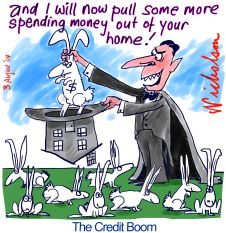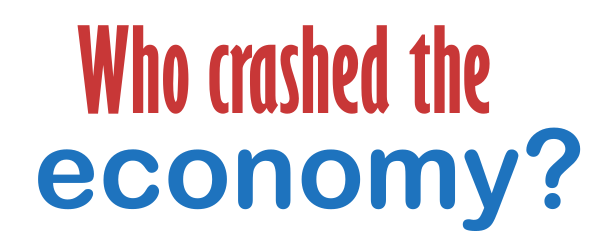This week saw GDP figures released showing the Australian economy is the fourth-best performing in the world behind China, India and Korea according to analysis by Royal Bank of Scotland. But is the Australian economy just extremely resilient, or have we not begun to see the start of the crisis in Australia? I’ve spent the month explaining to people that Australian’s have been spending more that they earned, ran out of access to cheap credit and then Rudd has given everyone an unprecedented stimulus package, so they can continue to plod on and spend more than they earn (or at least until the stimulus runs out). The green shoots are nothing more than the results of an unprecedented stimulus package, and certainly nothing sustainable. Today, I came across a post in a forum which I thought summed it up perfectly :
|  3rd August 2004 |
So the big question is what is next?
We have already kicked into September and the countdown has begun for the winding back of the First Home Owners Boost. The 31st marks the last day for the $14,000 Boost. From next month, until the 31st December, the Boost halves to $10,500 before resetting back to $7000 next year.
This has the property lobby groups in overdrive, trying to work out how to keep the bubble inflated come the end of the month. Endless articles of low vacancy rates, rising rents and using your SMSF to invest in property has hit the news sites in a desperate bid to try to encourage investors to pick up any shortfall left behind from the First Home Buyer.
The other question is when is the next stimulus package coming out, so we can keep spending more than we earn?
Over the weekend, Finance ministers and central bankers from the G20 countries have been discussing the coordinated unwinding of the stimulus measures. They indicated the need for “swift and full implementation” of the stimulus measures announced earlier this year, and the drawing up of “transparent and credible process” for ending these unprecedented stimulus measures.
This weekend also saw a speech released by Kansas City Fed President Thomas Hoenig, which claims while the U.S. appears to start rising to recovery, too little has been done to resolve the underlying problem off two much debt.
Hoenig, said the Fed has tried too hard to boost growth in the past by keeping rates low. But low rates only encouraged more debt, and fueled an increase in the money supply that has eroded purchasing power.
Sustainable growth can’t be achieved that way, he said.
The federal government has taken on much more debt in an effort to stimulate the economy, he said. Consumer debt remains bloated. And the biggest banks are still overleveraged by about $5 trillion, he said.
The way out of the swamp will be tricky, he said.
Back home in Australia, we are no different. While we are one year into the GFC, the underlying fundamentals have not changed. Cheap credit and the FHOB has only encouraged more Australian’s into mountains of household debt. The economic stimulus has done little to reduce household debt as a percentage of household disposable income.
The next few months will be interesting.

If South Australia’s any indication of the rest of the nation (and it usually is due to it’s conservativeness), the economy is slowing down FAST again….Better get stimulus #3 happening soon MR. Rudd. You got an election to win next year.
Thanks for the article. I always look forward to reading your latest post.
“The next few months will be interesting.”
I’ve found myself saying this quite a few times, ever since I first became aware of the sub-prime crisis after watching 4Corners back in Oct 2007 (approximately). I guess GFCs take quite a while to play out. I look at this graph every few months or so and keep wondering about a W shaped “recovery”.
http://dshort.com/charts/bears/four-bears-large.gif
I guess, from a layman’s perspective, the more leveraged people get, the less they can afford to spend on other things and thus at some stage a tipping point is reached in which the economy contracts. This tipping point will more than likely result in houses slowly starting their downhill slide?
The SMSF angle has the potential to take off as confidence returns, with boomers sinking their super funds into the property market in a last-ditch attempt to catch a new wave of rising values. Boy, that would be the blow-off top to end them all. The crash at the other end would be spectacular.
Love this site and Yes, what next??? We have sold our property at the start of the year thinking things couldnt get any sillier and yet they still seem too. We have owned a couple of small farms in the country for the last 13 years and it is very difficult adjusting to renting again and being treated like a peon. Any bozo can get a mortgage these days so if your renting your often treated like a major loser. I am so frustrated at the continuing madness and our inability to purchace anything descent without paying at least (conservative) double the price for acreage and house several hours from MELB or Syd (and they have sold almost nothing of the $500k+ properties over the last two years (BB’s too old for hobby farms)). When will this end??? Quite frankly being debt free sucks at the moment. Lots of dosh but i’ll be damned if i i’m going to cave in now after all the hassle we’ve been through. Waitng for reality to kick……………..
This reminded me of a conversation i had with a friend just last month. He argued the whole stimulus package was a ‘complete waste of time’ that will ‘achieve little’ favouring income tax cuts as a more long-term solution. My concern, on the other hand, was not that the stimulus wasn’t effective, but that it was actually doing its job, and giving us a false impression of consumer and retail spending.
I sincerely hope, for the country’s sake, that we are wrong.